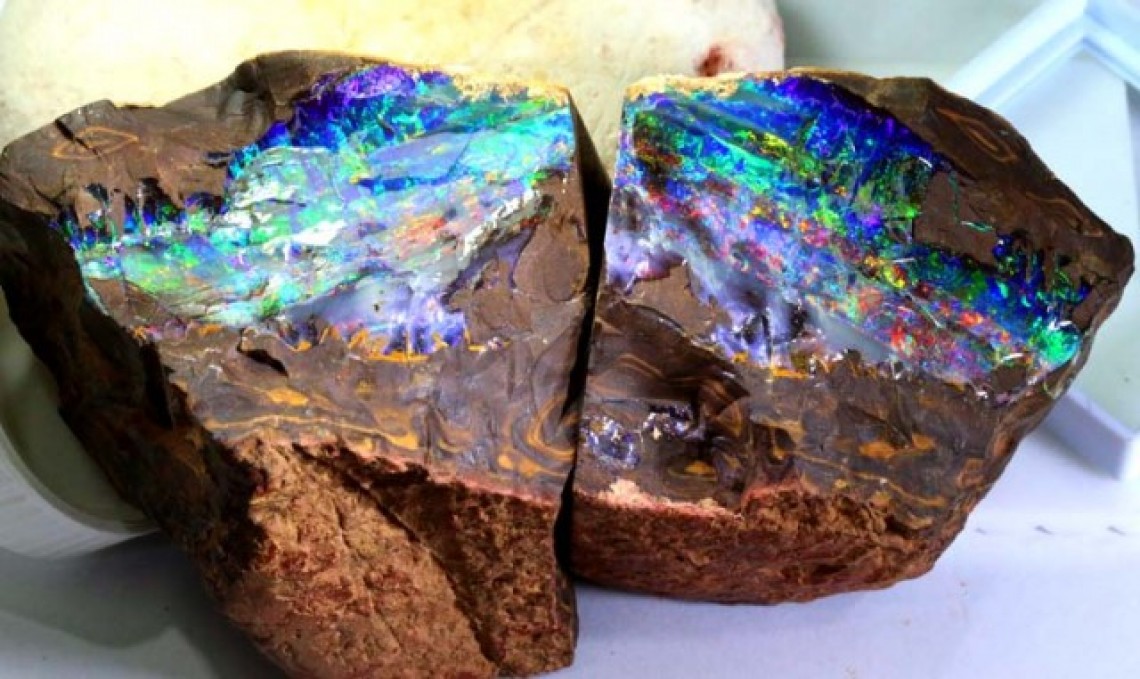
公開日8th May 2018
変更日時17th Nov 2025
オパールとは

オパールは、非結晶性のシリカ鉱物です。オパールは、石英や瑪瑙といった、より一般的な結晶質の石と同族です。オパールは、天然のファセット結晶ではなく、非晶質のシリカの塊から形成される点で異なります。オパールの化学組成はSiO2H2O、つまり二酸化ケイ素と水(オパールには最大30%の水分が含まれる場合があります)です。オパールのモース硬度は、石英の硬度に相当する6.0~6.5です。オパールのほとんどは、6500万年以上前から1億4500万年以上前のもので、恐竜が地球を闊歩していた時代の白亜紀の岩石層で発見されています。
オパールは、かつて地熱温泉が湧き出ていた地表近くで見つかることが多いです。鉱物は地表下から湧き上がり、何世紀にもわたってゆっくりと岩盤の空洞の壁を覆ってきました。世界の高品質な宝石オパールの90%以上は南オーストラリア産ですが、エチオピア、ブラジル、メキシコ、チェコスロバキア、ネバダ州など、世界各地でも産出されます。ブラックオパールはすべてオーストラリア産です。
オパールを分かりやすく定義すると、それは植物、木材、骨などの腐敗した空洞から発生する二酸化ケイ素という化学物質から固まった固体宝石鉱物(鉱物としての性質を持つが、鉱物ではない)です。科学的には、オパールはSiO₂・nH₂O、つまり二酸化ケイ素と水の混合物として知られています。他の宝石とは異なり、オパールには白、青、赤、黒、そして無色など、様々な種類があります。その最大の特徴は、通過する光の干渉と回折によって生じるスペクトルのあらゆる色を呈することです。つまり、オパールの鮮やかな虹色は、見る角度によって変化し、その輝きは劇的に変化します。 
オパールの種類
オパールには、プレシャス オパールとコモン オパールの 2 種類があります。プレシャス オパールは遊色現象と呼ばれる特徴を示し、比較的希少です。コモン オパールは光沢がなく価値がなく、世界中に豊富に産出されます。コモン オパールには遊色現象はありません。コモン オパールがプレシャス オパールと一緒に見つかった場合、ポッチ オパールと呼ばれます。オパール鉱山から採掘されるオパールの約 95% はコモン オパールまたはポッチ オパール、つまり基本的に単色です。残りの 5% には多少の色がありますが、その約 95% は並グレードです。したがって、実際に価値があるのは約 0.25% だけです。その他の種類のオパールには、透明から半透明のファイア オパール、ペルー オパールと呼ばれるブルー オパール、主にメキシコで産出され、遊色現象ではなく光源を追う青みがかった輝きや光沢を示すヒラソル オパールなどがあります。

オパールは堆積性です
オパールは、堆積岩起源の希少な宝石の一つです。オパールには今もなお6~10%の水分が含まれており、これは太古の海の名残です。オーストラリアの金採掘者が初めて貴重なオパールを発見したのは1863年のことです。世界で安定的に産出される商業用オパールの大部分はオーストラリア産で、オパールの産地は大きく分けて3つの地域に分けられます。ライトニングリッジ(ブラックオパールの産地)、南オーストラリア州のクーバーペディ、ミンタビー、ランビーナ、アンダムーカ(ライトベースオパールの主な産地)、そしてクイーンズランド州のボルダーオパールの産地です。
乳白色
オパールの最も印象的な特徴は、特定の波長の光を屈折・反射する能力です。実際、「オパールエッセンス」という言葉は、この現象を説明するために造られました。石内部の非晶質シリカ球の大きさと間隔によって、特定の波長の光を屈折させます。それぞれの球は、虹の中の水滴のように、単一の純粋なスペクトル色を屈折します。これらの純粋な光の波長の相互作用がオパールに独特の視覚的魅力を与え、世界で最も人気の高い宝石の一つとなっています。

オパールの歴史
オパールには、きらめく虹、花火、稲妻といった空の神秘が宿っています。空のように、オパールの色は動きに合わせて変化し、きらめきます。色と模様の組み合わせが、一つ一つのオパールを唯一無二の存在にしているのです。ブラックオパールは1800年代後半にオーストラリアで初めて発見されました。それ以前は、世界はクリスタルオパールしか知らず、主に東ヨーロッパで採掘されていました。歴史を通して、特にヨーロッパとアフリカの多くの王族がオパールを大切にしてきました。記録に残る最古のオパールは、著名な考古学者ルイス・リーキーによって発見されました。彼はケニアの洞窟で、6000年前のオパールの遺物を発見しました。ローマの歴史家プリニウスは、オパールを宝石の女王と正しく表現しました。オパールは他のあらゆる宝石の美しさを併せ持つからです。「ルビーよりも柔らかな輝きを放ち、アメジストの鮮やかな紫、エメラルドの海の緑。これらすべてが信じられないほどの調和の中で輝きを放っています。その輝きは画家の色彩に匹敵するものもあれば、燃え盛る硫黄の炎や油で燃え上がる炎に匹敵するものもあるのです。」
オパールは、クレオパトラやマルクス・アントニウスなど、歴史に名を残す偉人たちに愛されてきました。マルクス・アントニウスの同僚のローマ元老院議員の一人は、クレオパトラを彷彿とさせるオパールを所有していました。そのため、マルクスはどうしてもそのオパールを手に入れたいと思っていました。しかし、その議員が売却を拒否したため、マルクスは亡命させられました。フランス皇帝ナポレオンは、ジョセフィーヌに「トロイの炎」と呼ばれる鮮やかな赤い輝きを持つ美しいオパールを贈り、彼女をヘレネとしました。
オパールは文学でも有名です。シェイクスピアは、オパールの色彩の遊びを心の遊びに例え、文学における宝石の象徴性を用いた最も有名な例えを挙げています。『十二夜』の中で、彼はこう記しています。「憂鬱な神が汝を守り、仕立て屋が変わりやすいタフタで汝の服を仕立てますように。汝の心はオパールなのですから。」数世紀の間、オパールは歴史から姿を消したかに見えました。しかし、近代に入り、ヴィクトリア女王がオパールへの関心を再び呼び起こしました。ヴィクトリア女王はオパールを愛し、結婚祝いに贈ることもしばしばでした。彼女と娘たちは、オパールを身につけるファッショントレンドを生み出しました。
ヴィクトリア女王は、オーストラリアという刺激的な新産地から産出されるオパールをいち早く評価した人物の一人です。オーストラリア産オパールの歴史は、1億年以上前、中央オーストラリアの砂漠が広大な内海であり、その海岸線にはシリカを豊富に含んだ堆積物が堆積していた時代に遡ります。この内海が後退して消滅し、広大なアーテジアン盆地となった後、3000万年前の風化作用によって大量のシリカが溶液中に溶け出し、岩の割れ目や粘土層、さらには化石までも埋め尽くしました。このシリカの一部が貴重なオパールとなったのです。
オーストラリアオパール
オパールは主にオーストラリアで産出されます。正確には、その95%がオーストラリアで産出され、この国の国石となっています。最大かつ最も価値の高いオパールであるオリンピック・オーストラリスは、1956年にオパールの主要産地であるクーバーペディで発見されました。オパールの産地としては、エチオピア、ネバダ州、アイダホ州、そして火星などがあり、2008年にはNASAが火星でオパール鉱床を発見しました。エチオピア産オパールは、ウォロ州と北シェワ州で産出されます。ウォロ・オパールは「ウェロ」または「ウェロ」オパールとも呼ばれ、宝石取引においてエチオピア産オパールの主流となっています。スミソニアン協会には、ネバダ州ヴァージン・バレー産の未研磨および研磨済みのブラックオパールが収蔵されています。研磨されていないオパールは「ローブリング・オパール」として知られ、1917年に発見され、2,585カラットあります。研磨されたオパールは「ブラック・ピーコック」と呼ばれ、160カラットです。

ブラックオパールの主な産地は、オーストラリア、ニューサウスウェールズ州のライトニングリッジで、南オーストラリア州のミンタビーも、それよりは少ないものの産地です。最も人気のブラックオパールは、黒地に赤や多色の模様が入ったもので、見つけるのは非常に困難です。このような石は常に産地でカットされ、すぐに販売されます。ボルダーオパールは、茶色の鉄鉱石団塊から生成されるオパールで、カットすると濃い茶色のベースに薄いオパール層が現れるのが特徴です。このオパールは非常に美しいものもあり、ライトニングリッジ産のオパールは、世界で最も優れた輝きを持つオパールと称されることが多いです。
オパールは世界で最も美しく貴重な宝石の一つであり、ダイヤモンド、ルビー、サファイア、エメラルド、真珠とともに、歴史を通じて使用されてきた6種類の宝石の一つです。「オパール」という言葉はローマ語の「opalus」に由来し、サンスクリット語の「úpala」から派生したものです。10月の誕生石でもありますが、19世紀以降、オパールをプロットの仕掛けとして用いた小説『アンヌ・オブ・ガイエルシュタイン』の影響で、不運や死と結び付けられるようになりました。しかし、オパールには「邪眼を保つ」という迷信があるにもかかわらず、宝石コレクターの間では今でも人気があり、求められています。なぜなら、オパールは宝石愛好家にとって魅力的なコレクターズアイテムだからです。
オパールを買う
Opal Encyclopedia検索
最新記事
ブラックオパールは、オパールの中でも最も人気のある種類です。深いベースが表面に虹色の輝きを放ちます。ブラックオパールの用途、特性、歴史、そして価値についてご紹介します。
7th Dec 2025
オパールの等級付け方法と価格に影響を与える要因をご紹介します。色や輝き、カットや産地など、それぞれのオパールの価値がどのように評価されるのか、価格帯の例とともにご紹介します。
19th Jul 2023
記事のカテゴリ
All there is to know about Opals including Black Opals, Ethiopian Opals & Boulder Opal
14記事数
Check out our fascinating information and articles on all things amazing in the Opal world
41記事数




